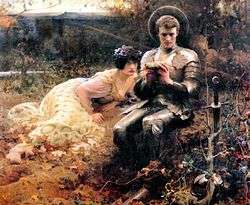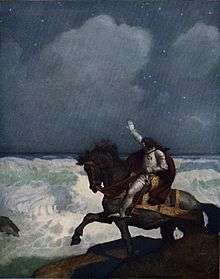Percival
| Percival | |
|---|---|
| Matter of Britain character | |
 How Sir Galahad, Sir Bors and Sir Percival Were Fed with the Sanc Grael; But Sir Percival's Sister Died by the Way, an 1864 watercolour by Dante Gabriel Rossetti | |
| Information | |
| Occupation | Knight of the Round Table |
| Title | Sir |
| Family | Pellinore, Lamorak, Aglovale, Tor, Lohengrin |
Percival (/ˈpɜːrsɪvəl/)—or Perceval, Percivale, etc.—is one of King Arthur's legendary Knights of the Round Table. First made famous by the French author Chretien de Troyes, in the tale Perceval, the Story of the Grail, his story was allotted to the fictional figure of Peredur son of Efwc in the Welsh adaptation of Chretien's tale titled Peredur, Son of Efrawg. He is most well known for being the original hero in the quest for the Grail before being replaced in later literature by Galahad.
In Arthurian legend


Chrétien de Troyes wrote the first story of Percival, Perceval, the Story of the Grail in the late 12th century. Wolfram von Eschenbach's Parzival, Thomas Malory's Le Morte d'Arthur, and the now-lost Perceval of Robert de Boron are other famous accounts of his adventures.
There are many versions of Perceval's birth. In Robert de Boron's account Saint Graal, he is of noble birth; his father is stated to be either Alain le Gros, King Pellinore or another worthy knight. His mother is usually unnamed but plays a significant role in the stories. His sister is the bearer of the Holy Grail; she is sometimes named Dindrane. In tales where he is Pellinore's son, his brothers are Sir Aglovale, Sir Lamorak and Sir Dornar, and by his father's affair with a peasant woman, he also has a half-brother named Sir Tor.
After the death of his father, Perceval's mother takes him to the forests where she raises him ignorant to the ways of men until the age of 15. Eventually, however, a group of knights passes through his wood, and Perceval is struck by their heroic bearing. Wanting to be a knight himself, the boy leaves home to travel to King Arthur's court. In some versions his mother faints in shock upon seeing her son leave. After proving his worthiness as a warrior, he is knighted and invited to join the Knights of the Round Table.
In the earliest story about him, he is connected to the Grail. In Chrétien's Perceval, he meets the crippled Fisher King and sees a grail, not yet identified as "holy", but he fails to ask a question that would have healed the injured king. Upon learning of his mistake he vows to find the Grail castle again and fulfill his quest but Chretien's story breaks off soon after, to be continued in a number of different ways by various authors, such as in Sir Perceval of Galles.
In later accounts, the true Grail hero is Galahad, Lancelot's son. But though his role in the romances had been diminished, Percival remained a major character and was one of only two knights (the other was Sir Bors) who accompanied Galahad to the Grail castle and completed the quest with him.
In early versions, Perceval's sweetheart was Blanchefleur and he became the King of Carbonek after healing the Fisher King, but in later versions he was a virgin who died after achieving the Grail. In Wolfram's version, Perceval's son is Lohengrin, the Knight of the Swan.
Modern interpretations

In modern times his story has been used in various retellings, including Richard Wagner's 1882 opera Parsifal, and the 2000 book Parzival: The Quest of the Grail Knight by Katherine Patterson.
- Richard Monaco's 1977 book Parsival: Or, a Knight's Tale is a re-telling of the Percival legend.[1]
- Éric Rohmer's 1978 film Perceval le Gallois is an eccentrically staged interpretation of Chrétien de Troyes's original poem.[2]
- John Boorman's 1981 film Excalibur in a retelling of Le Morte d'Arthur in which Percival (Perceval) is given a leading role.
- The 1991 film The Fisher King written by Richard LaGravenese is, in ways, a modern retelling in which the parallels shift between characters, who themselves discuss the legend.
- Percival is portrayed in the 2007 video game Sonic and the Black Knight as Blaze the Cat.
- The main character of Ernest Cline's 2011 novel Ready Player One (and its film adaptation) names his virtual reality avatar "Parzival" as a reference to Percival and to his role in Arthurian legend.
- In the 2017 television series "Knightfall", Percival (rendered as "Parsifal") appears as a young peasant farmer who joins the Knights Templar as a novice Knight.
- In the TV show Merlin, Sir Percival appears as a recurring main character
References
- ↑ Fries, Maureen, and Thompson, Raymond H. (1991). "Richard Monaco". In Norris J. Lacy (Ed.), The New Arthurian Encyclopedia p. 326. New York: Garland. ISBN 0-8240-4377-4.
- ↑ Lacy, Norris J. (1991). "Eric Rohmer". In Norris J. Lacy (Ed.), The New Arthurian Encyclopedia, p. 389. New York: Garland. ISBN 0-8240-4377-4.
Sources
- Chrétien de Troyes, Nigel Bryant (translator) (1996) Perceval, the Story of the Grail, D. S. Brewer. ISBN 0-85991-224-8.
- Chrétien de Troyes, D. D. R. Owen (translator) (1988) Arthurian Romances, Tuttle Publishing, reprinted by Everyman. ISBN 0-460-87389-X.
- Lacy, Norris J. (Ed.) (1991). The New Arthurian Encyclopedia. New York: Garland. ISBN 0-8240-4377-4.
External links
| Wikimedia Commons has media related to Percival. |